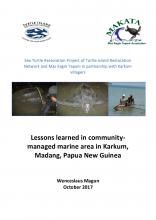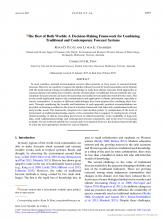Sea Turtle Restoration Project of Turtle Island Restoration Network and Mas Kagin Tapani in partnership with Karkum villagers - Lessons learned in community-managed marine area in Karkum, Madang, Papua New Guinea
This paper was informed by literature review, review of project activities and interviews with key leaders from Karkum, and other local communities the Sea Turtle Restoration Project (STRP) team has worked with in Madang, Papua New Guinea. Local communities and other stakeholders were informed about the critical status of the Pacific leatherback sea turtle (Dermochelys coriacea) which is being pushed to the verge of extinction. The paper further showed the seven resource management planning steps used that enabled Karkums to establish their Community-managed Marine Area using Conservation Deed (CMMA-CD) on 17th November 2008. The Karkum STRP experience points out that some of the root causes of environmental destruction, often begins with lack of community control over resources and the inequitable distribution of money and power. These conflicts are further inflamed by misconceived cargo cult demands. To overcome some of these challenges, the paper indicated that Mas Kagin Tapani (MAKATA) needs long-term funding to carry out further turtle awareness, and conduct problem tree analysis workshop(s) to review the Karkum-Mirap conservation Map, and the Karkum CMMA-CD. Funds will also be used to carry out sea turtles tagging and beach monitoring exercises, conduct a training needs analysis study, and meet the recommendations identified in the training needs analysis study. If funded MAKATA will continue to develop and distribute educational awareness materials to local communities and other stakeholders. The paper revealed further that additional funds are needed by MAKATA to build its infrastructure, recruit staff, and meet its management and governance issues.

